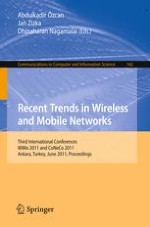2011 | Buch
Recent Trends in Wireless and Mobile Networks
Third International Conferences, WiMo 2011 and CoNeCo 2011, Ankara, Turkey, June 26-28, 2011. Proceedings
herausgegeben von: Abdulkadir Özcan, Jan Zizka, Dhinaharan Nagamalai
Verlag: Springer Berlin Heidelberg
Buchreihe : Communications in Computer and Information Science
